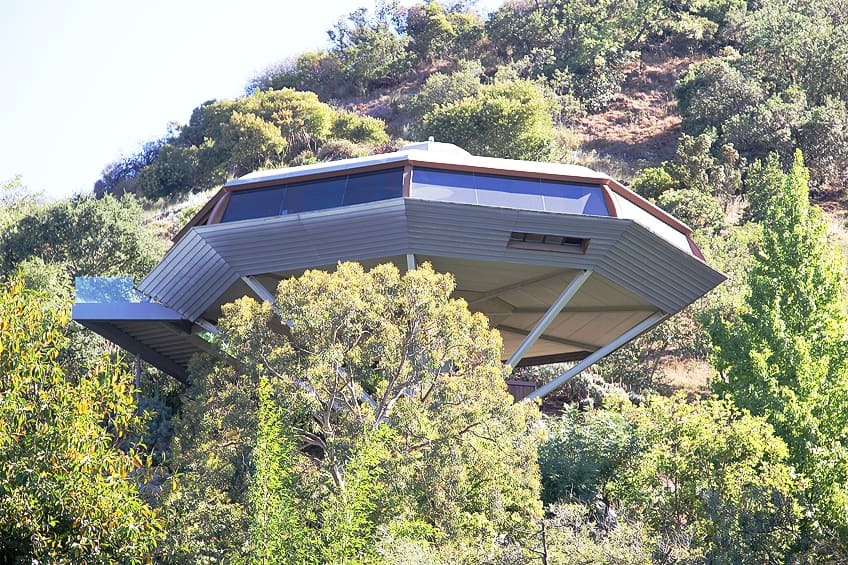Chemosphere House – Futuristic Living
The Chemosphere House, an iconic mid-century modern marvel perched atop the Hollywood Hills like a futuristic flying saucer, stands as a testament to architectural innovation and imagination. Designed by architect John Lautner in 1960, this groundbreaking residence defies gravity with its octagonal shape and cantilevered design, offering panoramic views of Los Angeles while blending seamlessly into its natural surroundings. With its pioneering use of space-age materials and visionary approach to living, the Chemosphere House continues to inspire architects and enthusiasts alike, embodying the spirit of architectural daring and forward-thinking design.
Table of Contents
Key Takeaways
- The Chemosphere House is a recognizable piece of modernist architecture designed by John Lautner.
- Its construction showcases an innovative solution to difficult terrain with a distinctive octagonal shape raised by a single column.
- The house has achieved historical significance and is a celebrated example of Lautner’s impact on Los Angeles architecture.
Historical Context
Perched high above the Los Angeles skyline, the Chemosphere House stands as a testament to innovative architectural design. Designed by architect John Lautner in 1960, this modernist abode captivates with its futuristic silhouette and engineering marvel. The house is a symbol of Lautner’s genius and his ability to push the boundaries of conventional architecture.

The Chemosphere, also known as the Malin Residence, is a unique octagonal structure that is supported by a single concrete column, rising thirty feet above a steep hillside. This design was not only an ingenious solution to a challenging building site but also created a house that appears to hover in mid-air, offering panoramic views of the San Fernando Valley. Though originally met with skepticism, it has earned worldwide recognition for its distinctive design and structural ingenuity.
Leonard Malin as the Client
Leonard Malin, an aerospace engineer, commissioned the creation of the Chemosphere. Tasked with the challenge of constructing on a steep hillside lot, Malin entrusted architect John Lautner to craft a home that would not only accommodate the difficult topography but do so within a budget of $30,000.
The result was a feat of engineering—a house perched upon a single concrete pillar that remains an exemplar of modernist architecture.
Cultural Impact in Media
Beyond its architectural significance, the Chemosphere has made notable appearances in various media, cementing its status as a Hollywood cultural landmark. It has been featured in films and television series, including Charlie’s Angels and an episode of The Simpsons, showcasing its distinctive flying saucer-like silhouette. These appearances contribute to the Chemosphere’s enduring recognition and illustrate its influence on popular culture and architectural appreciation.
Architectural Significance
The Chemosphere stands as a quintessential model of architectural innovation, encapsulating John Lautner’s unique vision and its lasting impact on modern residential design.
Design and Innovation
The structure, completed in 1960, is renowned for its ingenious design that involved situating a futuristic octagonal home atop a single concrete column. This feat was accomplished through the use of materials such as laminated wood and steel, facilitating a balance that allows the house to ‘float’ above the rugged landscape. By addressing the challenge of a steep hillside, the Chemosphere became a symbol of innovative solutions in architectural design.
John Lautner’s Vision
Lautner, a pupil of Frank Lloyd Wright, envisioned the Chemosphere as a harmonious blend of form and function. His design philosophy is crystallized in this project, as he turns a challenging site into an opportunity for creative expression.
Not only does the house boast a striking appearance, but it also provides a livable and functional space that defies traditional residential architecture.
Influence on Modern Architecture
Deemed by many as the most modern home of its era, the Chemosphere has significantly influenced contemporary architects. Its bold use of a singular support structure and its adaptation to the environment are principles seen in many later works. The house endures as an iconic piece of architecture that continues to inspire and inform the design of modern homes around the world.

Technical Aspects
The Chemosphere House is a testament to innovative design, addressing the unique challenges of its steep site with distinctive engineering and material choices.
Engineering Challenges
The Chemosphere, perched in the hills of the San Fernando Valley, faced the significant challenge of building on a slope considered unbuildable. Traditional construction methods were inadequate for the steep site. Architect John Lautner’s solution was to support the octagonal structure atop a single 29-foot high, five-foot-wide concrete column, giving the residence its iconic appearance that suggests a “UFO on a stick.”
The Funicular was introduced to address accessibility due to the house’s remote location and connected the residence to the hillside below, easing transportation challenges.
Materials and Construction
Key Construction Materials:
- Structure: Predominantly steel and concrete.
- Ensured stability within the earthquake-prone region of Southern California.
- Exterior: The distinctive use of materials reflected the mid-century modern aesthetic.
During construction, Lautner utilized innovative techniques and materials available at the time to ensure the house could withstand not only the gravitational challenges but also provide resilience against seismic activity, an important consideration for structures in Southern California.
Restoration and Preservation
By the 1990s, the Chemosphere required significant restoration to preserve its unique architectural character. Architect Frank Escher undertook the task, meticulously restoring the house to its former glory. Addressing the infrastructure, the Chemosphere House underwent significant upgrades, including the renovation of the funicular for enhanced functionality. The home’s foundation was also reinforced, bolstering its earthquake resilience and ensuring long-term stability.
Restoration efforts were carried out in collaboration with Southern California Gas, focusing on technological advancements while preserving the integrity of John Lautner’s original design by using period-appropriate materials wherever feasible. These meticulous efforts not only enhanced the house’s functionality and safety but also honored its architectural legacy.
This sensitive approach to preservation has allowed the Chemosphere to continue to function as a private residence while also serving as an iconic example of architectural ingenuity.
Public Recognition and Legacy
The Chemosphere House, an iconic piece of architecture, has garnered significant accolades and media attention throughout its existence, securing a place in not just architectural history, but also in popular culture. Its status is reflected in various acknowledgments and its current relevance.
Architectural Accolades
The ingenuity of the Chemosphere’s design has been recognized by architects and critics alike. It is designated as a Los Angeles Historic-Cultural Monument, which places it amongst the city’s esteemed historical sites. This honor signifies the city’s recognition of the house’s architectural significance. Encyclopedists, such as those from Encyclopedia Britannica, have lauded it as a remarkably modern home upon its creation. Its unique design continues to be a subject of study and appreciation within architectural circles.

Media Features
Publishers and content creators have often showcased the Chemosphere House, underlining its influence on modern architecture. Benedikt Taschen, a renowned publisher, found the house compelling enough to become its owner, which underlines the cultural and aesthetic appeal the building commands. The Chemosphere has also graced various media platforms, elevating its profile to an iconic status.
It has been featured in films, advertisements, and an array of photographs that circulate in popular media, contributing to its legacy as an emblematic figure within the architectural landscape.
Chemosphere House Today
Today, the Chemosphere House remains a testament to innovative design, continuously drawing interest from architectural aficionados and the general public. Its use of a single concrete pillar for support on a steep hillside is as much a conversation starter now as it was in the past. The owner, Taschen, has ensured through renovations that the structure maintains its original futuristic charm and functionality, keeping it relevant in modern discussions of architectural innovation. The house’s current state, well-preserved and visually striking, allows it to continue influencing contemporary designs and to serve as a physical reminder of a bold architectural era.
The Chemosphere House remains a timeless icon of architectural ingenuity, showcasing John Lautner’s mastery of form, function, and futuristic vision. Its enduring appeal lies not only in its striking design but also in its ability to harmonize with nature and command breathtaking views of its urban backdrop. As a symbol of mid-century modernism’s daring spirit and ongoing relevance, the Chemosphere House stands as a reminder that great architecture transcends time, leaving an indelible mark on the landscape and inspiring future generations of architects and dreamers.
Frequently Asked Questions
What Is the History of the Chemosphere House?
The Chemosphere house, designed by architect John Lautner in 1960, stands as an iconic example of modernist architecture in Los Angeles. Initially built for aerospace engineer Leonard Malin, this distinctive octagonal home is perched atop a five-foot-wide concrete column, resembling a flying saucer.
How Can One Take a Tour of the Chemosphere House?
Tours of the Chemosphere house are not regularly available to the public as it remains a private residence. However, on rare occasions, the owner may allow access for special events or architectural tours arranged through organizations dedicated to preserving architectural heritage.
Who Is the Current Resident of the Chemosphere House?
As of the knowledge cutoff date in 2023, the Chemosphere house is owned by James Goldstein, who purchased the property in the 1970s. Goldstein has been responsible for maintaining and restoring the structure in collaboration with John Lautner until the architect’s passing in 1994.
Isabella studied at the University of Cape Town in South Africa and graduated with a Bachelor of Arts majoring in English Literature & Language and Psychology. Throughout her undergraduate years, she took Art History as an additional subject and absolutely loved it. Building on from her art history knowledge that began in high school, art has always been a particular area of fascination for her. From learning about artworks previously unknown to her, or sharpening her existing understanding of specific works, the ability to continue learning within this interesting sphere excites her greatly.
Her focal points of interest in art history encompass profiling specific artists and art movements, as it is these areas where she is able to really dig deep into the rich narrative of the art world. Additionally, she particularly enjoys exploring the different artistic styles of the 20th century, as well as the important impact that female artists have had on the development of art history.
Learn more about Isabella Meyer and the Art in Context Team.
Cite this Article
Isabella, Meyer, “Chemosphere House – Futuristic Living.” Art in Context. April 15, 2024. URL: https://artincontext.org/chemosphere-house/
Meyer, I. (2024, 15 April). Chemosphere House – Futuristic Living. Art in Context. https://artincontext.org/chemosphere-house/
Meyer, Isabella. “Chemosphere House – Futuristic Living.” Art in Context, April 15, 2024. https://artincontext.org/chemosphere-house/.









